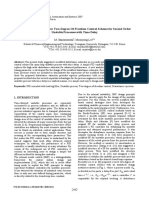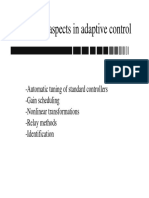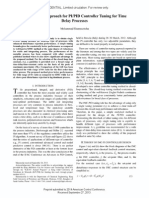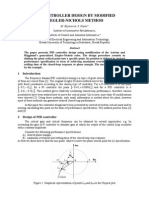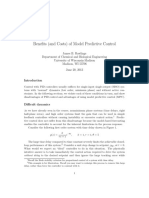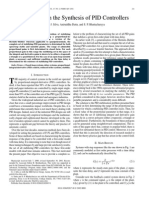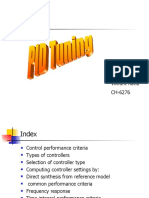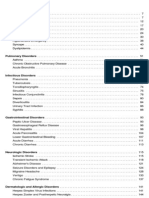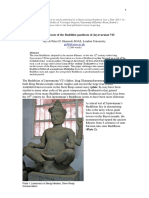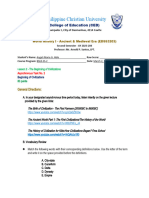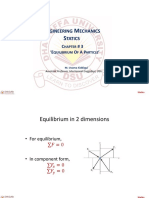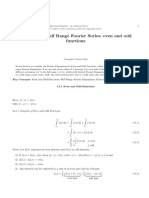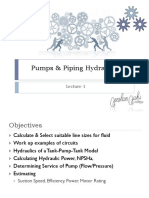Cohen & Coon Controller Tuning Example
C =
Gc
Ym
M
s
U = 0
Gd
Ga
Gp
+
+
Gm
For the Cohen & Coon PRC response to an open step change:
GPRC = Ga G p Gm =
Y = MK 1 e
Ke s
MKes MKe s MKe s
Ym =
=
s ( s + 1)
s
s + 1
s + 1
( t ) /
) S(t ) .
The suggested rules for finding this PRC from any step-change response curve is:
Draw a straight line tangent to the response curve at the point of inflection.
The apparent time delay is the point where this straight line intersects the time axis.
The apparent time constant is obtained from the slope of this straight line, S , and the
ultimate value of the response, Ym, . It is calculated as:
=
Ym,
The apparent process gain is obtained from the ultimate value of the response, ym , .
It is calculated as:
K=
Ym,
M
General 2nd Order Overdamped System Example
As an example, let's assume we have a 2nd order overdamped system with negligible dynamics in
the final control & measurement elements. Then:
Gp ( s ) =
Kp
( 1s + 1)( 2 s + 1)
Ga ( s ) = Gm ( s ) = 1
J.L. Jechura
-1-
April 18, 2003
�For the same step change, the response will be:
Y =
so:
MK p
s ( 1s + 1)( 2 s + 1)
MK p
s
MK p 12
MK p 22 1
1
+
1 2 1s + 1 1 2 2 s + 1
1
2
Y = MK p 1
e t / 1 +
e t / 2 .
1 2
1 2
Since we will be needing the point of inflection and its slope, then we also need expressions for
the 1st and 2nd time derivatives:
dY
1
= MK p
e t / 1
e t / 2
1 2
dt
1 2
d 2Y
1
1
e t / 1 +
e t / 2 .
= MK p
2
dt
2 ( 1 2 )
1 ( 1 2 )
The point of inflection is at time ti and can be found from:
d Y
1
e ti / 1
= MK p
2
( )
dt t =t
1 1 2
2
ln 1
1
e ti / 2 = 0 ti = 2
+
1 1
2 ( 1 2 )
2 1
We can now find the PRC parameters. The ultimate value will be:
1
2
Y = lim MK p 1
e t / 1 +
e t / 2 = MK p
t
1 2
1 2
So:
K = Kp
=
Kp
S
/ ( )
/ ( )
MK p 2 1 1 2 2 2 1 2
where: S = y ( ti ) =
1 2 1
1
Finally, we can find the dead time by putting a tangent line through the point of inflection. Then:
Y ( ti ) = S ( ti ) = ti
J.L. Jechura
y ( ti )
S
-2-
April 18, 2003
�1 / ( 1 2 )
2 / ( 1 2 )
MK p
2
2
( 1 2 ) + 2
where: Y ( ti ) =
1
1 2
1
1
Specific 2nd Order Overdamped System Example
Let us take for example the process:
Gp ( s ) =
1
( s + 1)( 5s + 1)
For a unit step change, the response will be:
1
5
Y = 1 + et et / 5
4
4
dY
1
1
= e t + e t / 5
dt
4
4
d 2Y 1 t 1 t / 5
= e + e
dt 2
4
20
The point of inflection is:
1
ln
5
5
ti = = ln 5 = 2.01118
1 1 4
5 1
then:
1 1
S =
4 5
=
5/ 4
1/ 4
1
1
=
= 0.133748
1/ 4
5 5 ( 5 )
1
= 7.47674
S
1 1
Y ( ti ) = 4 +
4 5
td = 2.01118
5/ 4
1/ 4
1
53/ 4
1
5 = 1+
= 0.197512
1/ 4
4
5
20 ( 5 )
0.197512
= 0.535053
0.133748
The following figure compares the exact response with this approximate response. Note that the
comparison is not very good, but what we really want is some approximate curve to estimate
what the controller settings ought to be.
J.L. Jechura
-3-
April 18, 2003
�1.2
1.0
Exact
0.8
Approximate
Y'(t) 0.6
0.4
0.2
0.0
0
10
15
20
25
30
35
The following will be the Cohen & Coon controller settings:
P control:
Kc =
7.47674
1
0.535053
1 + =
1 +
= 14.3
K 3 0.535053 3 7.47674
PI control:
Kc =
7.47674
1
0.535053
0.9 +
=
0.9 +
= 12.7
K
12 0.535053
12 7.47674
I =
30 + 3 ( / )
9 + 20 ( / )
= 0.535053
30 + 3 ( 0.535053 / 7.47674 )
9 + 20 ( 0.535053 / 7.47674 )
= 1.55
PID control:
Kc =
1 4 7.47674 4 0.535053
+ =
+
= 18.9
K 3 4 0.535053 3 4 7.47674
I =
32 + 6 ( / )
13 + 8 ( / )
D =
J.L. Jechura
= 0.535053
32 + 6 ( 0.535053 / 7.47674 )
13 + 8 ( 0.535053 / 7.47674 )
= 1.28
4
4
= 0.535053
= 0.19
11 + 2 ( / )
11 + 2 ( 0.535053 / 7.47674 )
-4-
April 18, 2003
�Non-Linear Fit to PRC Parameters
The use of the inflection point is fairly simple to match parameters for the PRC, but it does not
give a very good fit to the system's response. With today's proliferation of computers & data
manipulation software, it is almost as easy to fit the parameters using non-linear regression. This
can easily be done for the example 2nd order overdamped system using Excel's Solver function.
The parameters found are:
K = 1.00768
= 5.48522
= 0.727561
The following figure shows that these parameters give a much better fit to the actual response
curve.
1.0
0.9
0.8
Exact
Inflection Point Rules
Non-Linear Fit
0.7
0.6
Y'(t) 0.5
0.4
0.3
0.2
0.1
0.0
0
10
15
20
25
30
The following will be the Cohen & Coon controller settings:
P control:
Kc =
1
1
5.48522
0.727561
1 + =
1 +
= 7.81
K 3 1.00768 0.727561 3 5.48522
PI control:
Kc =
J.L. Jechura
1
1
5.48522
0.727561
0.9 +
=
0.9 +
= 6.82
K
12 1.00768 0.727561
12 5.48522
-5-
April 18, 2003
�I =
30 + 3 ( / )
9 + 20 ( / )
= 0.727561
30 + 3 ( 0.727561/ 5.48522 )
9 + 20 ( 0.727561/ 5.48522 )
= 1.90
PID control:
Kc =
1 4
1
5.48522 4 0.727561
+ =
+
= 10.2
K 3 4 1.00768 0.727561 3 4 5.48522
I =
32 + 6 ( / )
13 + 8 ( / )
D =
= 0.727561
32 + 6 ( 0.727561/ 5.48522 )
13 + 8 ( 0.727561/ 5.48522 )
= 1.70
4
4
= 0.727561
= 0.26
11 + 2 ( / )
11 + 2 ( 0.727561/ 5.48522 )
Effect of values on Closed Loop System Response
The controller settings from the two PRCs are quite different. The next logical question is how
different are the responses when control is turned on. Let's look at a step change to the load for
PI control when the transfer function for the disturbance is the same as that for the manipulated
variable, i.e., Gd = G p . The closed loop transfer function will be:
G (s) =
Gp
1 + Gc G p
1
( s + 1)( 5s + 1)
1
1
1 + K c 1 +
I s ( s + 1)( 5s + 1)
I s
K c + ( I + K c I ) s + 6 I s 2 + 5 I s 3
and with a step change to the load, U = 1/ s then:
Y (s) =
I
K c + ( I + K c I ) s + 6 I s 2 + 5 I s 3
The general solution for this can be quite messy (since there are real exponential terms if
overdamped and sine/cosine terms if underdamped). Let's only invert this for specific cases of
the controller variables. For the controller variables derived by fitting the PRC to the inflection
point:
Y ( t ) = 0.0800524e 0.686594t
+ e0.256703t 0.0226252sin (1.52104t ) 0.0800524 cos (1.52104t )
For the controller variables derived by fitting the PRC using non-linear regression:
Y ( t ) = 0.16672e 0.596944t
+ e0.301528t 0.0466982sin (1.05468t ) 0.16672 cos (1.05468t )
J.L. Jechura
-6-
April 18, 2003
�The following figure shows the response to this disturbance. Which set of controller settings
gives the best control depends upon your definition of best. The parameters derived from the
PRC fit to the inflection point produces a response with a smaller maximum offset, but the
parameters derived from the non-linear regression PRC fit produces a response with a better
decay ratio.
0.14
0.12
Inflection Point Fit
0.10
Non-Linear Fit
0.08
0.06
Y'(t)
0.04
0.02
0.00
-0.02
-0.04
0
10
15
20
J.L. Jechura
-7-
April 18, 2003









